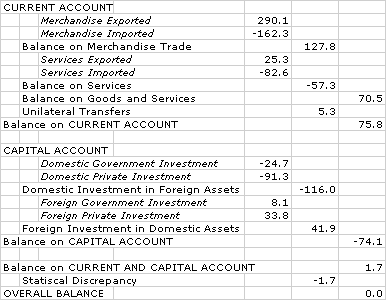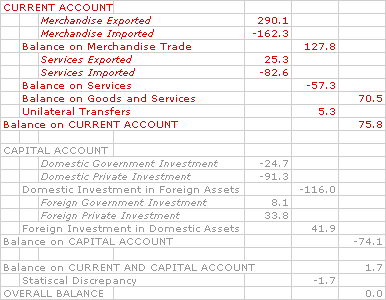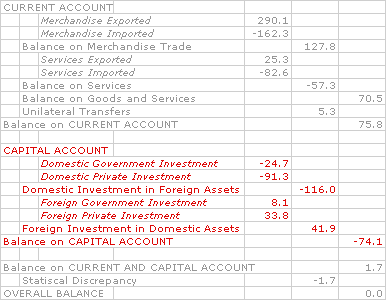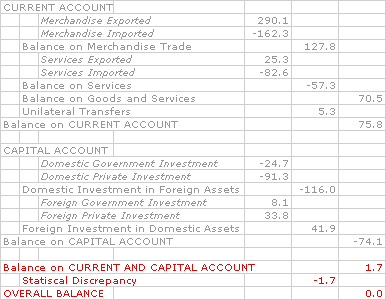
|
|
HERFINDAHL INDEX: A measure of concentration of the production in an industry that's calculated as the sum of the squares of market shares for each firm. This is an alternative method of summarizing the degree to which an industry is oligopolistic and the relative concentration of market power held by the largest firms in the industry. The Herfindahl index gives a better indication of the relative market control of the largest firms than can be found with the four-firm and eight-firm concentration ratios.
Visit the GLOSS*arama
|
|


|

|
                           BALANCE OF PAYMENTS: A comprehensive set of accounts that tracks the flow of currency and other monetary assets coming in to and going out of a nation. These payments are used for international trade, foreign investments, and other financial activities. The balance of payments is divided into two accounts -- current account (which includes payments for imports, exports, services, and transfers) and capital account (which includes payments for physical and financial assets). A deficit in one account is matched by a surplus in the other account. The balance of trade is only one part of the overall balance of payments set of accounts. The balance of payments provides a country with a record of international payment flows. While the balance of trade is one important part of the balance of payments account it is only part. The balance of payments is a comprehensive set of accounts that track all sorts of payments coming in to and going out of a nation for a wide variety of reasons. Specifically the balance of payments is the difference between all payments coming into a nation and those going out of the nation. It is the balance of international monetary transactions for a nation. The balance of payments is effectively the difference between the funds received by a country and those paid by a country for all international transactions. These international transactions include (1) the exchange of merchandise (exports and imports), which is the balance on merchandise trade, (2) the exchange of services, summarized as the balance on services, (3) any gifts or transfer payments that do not involve the exchange of goods and services, and the (4) the purchase of physical or financial capital assets. The balance of payments is divided into two accounts -- current account (which includes payments for imports, exports, services, and transfers) and capital account (which includes payments for physical and financial assets). Balance of Payments for Northwest Queoldiola| Balance of Payments |  |
| Current Account | 
|
To illustrate the balance of payments system of accounts, consider the Republic of Northwest Queoldiola, a hypothetical country that is well suited for this task. Other real world countries, such as the United States, Brazil, or Lichenstein, have similar accounts (albeit with different numbers).The chart to the right presents the hypothetical balance of payments for Northwest Queoldiola stated in terms of queolds, the hypothetical Queoldiolan currency. The balance of payments for real world countries is generally stated in terms of their domestic currencies (such as dollars for the United States or reals for Brazil). First note that this chart contains two major sections, Current Account and Capital Account. Details about both are forthcoming. Near the bottom of the chart is then a summary Balance of the Current and Capital Accounts,which combines the two sections. At the very bottom is finally the overall Balance of Payments. Why the overall balance is zero but the summary balance is not is worthy of further discussion and is also forthcoming. Current AccountThe Northwest Queoldiola balance of payments chart at the right highlights the current account. The current account is a record of all trade between one nation and other nations. It includes payments for imports and exports of both goods and services. It also includes monetary gifts or transfer payments to and from other nations. This account is divided into three categories -- balance on merchandise trade, balance on services, and unilateral transfers.- Balance on Merchandise Trade: A click of the [Mer Bal] button highlights the first portion of the Current Account. This is the difference between the payments received for exports of goods to other nations and the payments made for the imports of goods from other nations. The goods included are physical or tangible goods, but not intangible services. The balance merchandise is thus appropriately divided into Merchandise Exported and Merchandise Imported. Note Northwest Queoldiola exports more merchandise that it imports, hence the balance is a positive number.
- Balance on Services: A click of the [Ser Bal] button highlights the second portion of the Current Account. This is the difference between the payments received for exports of services to other nations and the payments made for the imports of services from other nations. This includes only intangible services. Once again a summary balance is provided for the trade in services, which for Northwest Queoldiola is negative, meaning that it exports fewer services than it imports.
- Unilateral Transfers: A click of the [Un Tran] button highlights the last portion of the Current Account. This is the difference between gifts or transfers received from other nations and transfers sent to other nations. In includes gifts or transfers between individuals, and perhaps more important, it includes transfers between governments. For Northwest Queoldiola transfers are positive because it receives more gifts from other countries than it gives out.
Note that the sum of the balance on merchandise trade and the balance on services is technically termed the balance on goods and services, or more commonly just the balance of trade. Click the [Trad Bal] button for a look. This value is positive if the exports of goods and services exceeds the imports of goods and services, which is a balance of trade surplus. A balance of trade deficit occurs if the exports of goods and services falls short of the imports of goods and services, and the resulting value is negative.Including unilateral transfers with the balance on goods and services provides a summary value of the balances of the current account, the last line in this section. Highlighting this can be done by clicking the [Cur Bal] button. For Northwest Queoldiola, this value is positive. Capital Account| Capital Account | 
|
| A Balance |  |
In the middle of the Northwest Queoldiola balance of payments chart is the capital account, as highlighted in the chart to the right. The capital account includes the flow of payments used to purchase financial and physical assets. Some folks in the foreign sector purchase assets in the domestic economy. And some in the domestic economy purchase assets in the foreign sector. These purchases are be made by individuals, business, and even governments.- Domestic Investment in Foreign Sector: A click of the [Dom Inv] button highlights this portion of the Capital Account. This is the net flow of payments used by those in the domestic economy to purchase financial and physical assets in other nations. The bulk of this category is purchases of foreign assets, especially physical capital, made by private domestic businesses. However, it also includes purchases of foreign assets, primarily financial assets, made by the domestic government (usually the central bank and usually in the conduct of exchange rate policies).
- Foreign Investment in Domestic Sector: A click of the [For Inv] button highlights this portion of the Capital Account. This is the net flow of payments used by those in the foreign sector to purchase financial and physical assets in the domestic economy. Once again, the majority of these payments is for the purchase of domestic physical capital by foreign sector businesses. However, purchases of financial capital issued by the domestic government, especially currency, is notable.
Summing the outflow of payments by the domestic sector for foreign assets and the inflow of payments by the foreign sector for domestic assets generates the balance on the capital account. For Northwest Queoldiola, this value is negative, as can be highlighted with a simple click of the [Cap Bal] button.A Balance of AccountsThis chart of the Northwest Queoldiola balance of payments highlights the summary balance portion of the statement. Interestingly, the balance on the current account for Northwest Queoldiola is a positive value and the balance on capital account is (almost) and equal negative value. Is this mere coincidence?Hardly. Summing the balance on the current account and the balance on the capital should, in theory at least, equal zero. That's what the "balance" in balance of payments is all about. Any net flow of payments for goods and services is offset by an equal but opposite net flow of payments for capital investments. In the balance of payments, the current account and capital account balance out to zero (in theory). This arises because the payments are made with the domestic currency of the nation (in this case, queolds used by Northwest Queoldiola). This currency is typically only the legal tender for the domestic economy and is, of course, limited in supply. Thus, any domestic currency that flows out of the country to purchase imports or invest in foreign assets must return (eventually) to the domestic economy to purchase exports or invest in domestic assets. What else could those in the foreign sector do with this currency? Let's look at this in other terms. A current account deficit arises if imports exceed exports (with adjustments for net transfers abroad). In this case, the domestic economy is sending more money out for these activities than it is receiving. A capital account surplus then arises if the foreign sector is buying relatively more domestic assets than the domestic sector is buying foreign assets. That is, the money flowing out of the domestic economy from the current account due to imports and exports is flowing back in to purchase domestic assets. This has an important implication. If the current account has a deficit, then the capital account has a matching surplus. Or if the current account has a surplus then the capital account has a matching deficit. While, in theory, the balance of payments is zero, in practice, measurement errors prevent an absolute balance. Note that while the summary Balance on Current and Capital Accounts is close to zero, it is NOT zero. It should be, but it is not. For this reason a "statistical discrepancy" is included that is exactly equal to be opposite of the Balance on Current and Capital Accounts. When combined, the Overall Balance is zero, exactly as it should be. Surplus or Deficit?The balance of payments account for a country, in theory, and thanks to the statistical discrepancy, in practice, achieve a balance. However, it is possible for a country to have a balance of payments surplus or deficit -- at least temporarily. Balance of payments surpluses or deficits can be achieved by fixing the currency exchange rate. - A Surplus: A balance of payments surplus would occur if the balance is greater than zero. This means that the country has a net inflow of payments. More payments are coming in to the country for exports, transfers, or investments than are going out. Fixing the currency exchange rate below the flexible exchange rate equilibrium level not only generates a balance of trade surplus (as the relatively low exchange rate encourages exports and discourages imports), but it can also temporarily generate a balance of payments surplus (as more payments come in for exports than go out for imports).
- A Deficit: Alternatively, a balance of payments deficit would occur if the balance is less than zero. This means that the country has a net outflow of payments. More payments are going of the country for imports, transfers, or investments than are coming in. Fixing the currency exchange rate above the flexible exchange rate equilibrium level not only generates a balance of trade deficit (as the relatively high exchange rate discourages exports and encourages imports), but it can also temporarily generate a balance of payments deficit (as fewer payments come in for exports than go out for imports).
Balance of payments surpluses and deficits are short lived. They are achieved by forcing an imbalance in the flow of currency either into or out of the country. Eventually this currency will begin to flow in the other direction. Of course the policy efforts to maintain the imbalance can be intensified to offset the natural counter-balancing flow.But such efforts cannot be maintained indefinitely. Eventually the country will pay out all of its domestic currency to other countries (with a balance of payments deficit) or domestically control all of the currency of other countries (with a balance of payments surplus). Neither of this options can actually occur.

Recommended Citation:BALANCE OF PAYMENTS, AmosWEB Encyclonomic WEB*pedia, http://www.AmosWEB.com, AmosWEB LLC, 2000-2025. [Accessed: July 3, 2025].
Check Out These Related Terms... | | | | | | | | |
Or For A Little Background... | | | | | | | | | | |
And For Further Study... | | | | | | | | | |
Related Websites (Will Open in New Window)... | | | | | | |
Search Again?
Back to the WEB*pedia
|



|

|
BLUE PLACIDOLA
[What's This?]
Today, you are likely to spend a great deal of time searching for rummage sales hoping to buy either a coffee cup commemorating the moon landing or a how-to book on surfing the Internet. Be on the lookout for pencil sharpeners with an attitude.
Your Complete Scope
This isn't me! What am I?
|

|
|
The first paper notes printed in the United States were in denominations of 1 cent, 5 cents, 25 cents, and 50 cents.
|

|
|
"Far and away the best prize that life has to offer is the chance to work hard at work worth doing." -- Theodore Roosevelt, 26th US president
|

|
IMF
International Monetary Found
|

|
|
Tell us what you think about AmosWEB. Like what you see? Have suggestions for improvements? Let us know. Click the User Feedback link.
User Feedback
|


|


